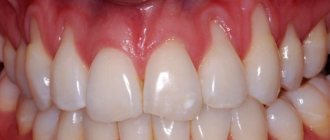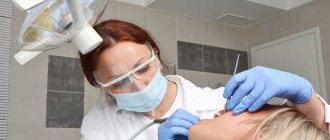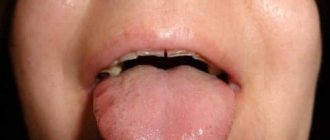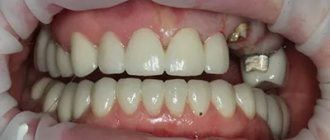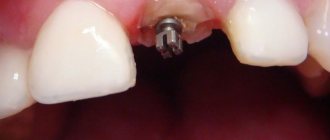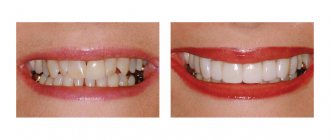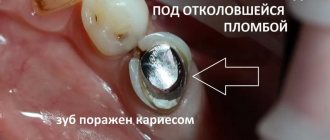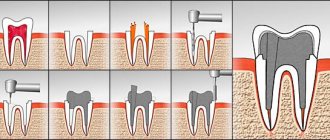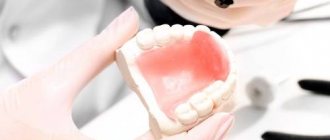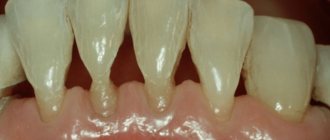Author: Brodsky Sergey Evgenievich Deputy Chief Physician, Candidate of Medical Sciences in the specialties: dentistry and medical microbiology A broken tooth is the cause of discomfort during eating, which can lead to the development of inflammatory processes in the hard and soft tissues of the tooth, root and gum . Therefore, if a defect is detected, you should immediately consult a dentist, who will select the correct method for restoring the tooth.
Causes of tooth fracture
Part of a tooth can chip or break as a result of exposure to internal and external factors. The first group of reasons include:
- pathologies associated with disruption of intrauterine development of surface and hard tissues of the tooth;
- metabolic disorders associated with impaired absorption of calcium, magnesium and phosphorus, provoked by rickets suffered in childhood, the use of diuretics, and poor nutrition;
- diseases of the digestive tract, accompanied by changes in the acidity of saliva, which has a destructive effect on tooth tissue.
A tooth in the gum can break under the influence of a number of external factors, including:
- injuries to the skull and jaw during a fight, road accident;
- tooth injury during dental procedures;
- eating solid foods;
- thermal injury due to the simultaneous consumption of cold and hot food and drinks;
- advanced carious processes;
- incorrect structure of the dentition.
Why can't we leave everything as it is?
When a person loses a tooth in the smile area, he usually tries to restore it - but with chewing teeth that are not visible, the situation is different. Many people think that if one chewing tooth is lost, then nothing bad has happened - the rest are in place, which means they can chew.
Each tooth in our jaw carries an important functional, and not just aesthetic, load. If the tooth is not restored, negative consequences will inevitably occur:
- improper distribution of the chewing load will lead to gradual destruction of the teeth next to the defect - after all, they will have to work for themselves and for the lost tooth;
- bone tissue atrophy will occur due to the fact that there is no load during chewing;
- Bite defects will appear - if a tooth has been missing for years, then its row neighbors gradually begin to shift towards the empty space;
- chewing food will not be of sufficient quality, which over the years will lead to the development of problems with the gastrointestinal tract;
- bite defects will negatively affect the functioning of the temporomandibular joint, which will provoke neck pain, headaches, discomfort and pain when opening the mouth or chewing, even insomnia;
- Diction problems will appear.
But how to place a tooth if there is no root?
The main goals of prosthetics are to return the patient to the ability to chew food normally, restore the aesthetics of a smile, and prevent further tooth decay due to chewing overload. Here are 3 main ways to insert a tooth:
- removable prosthetics
- making a prosthesis from nylon, acrylic, silicone, Acry Free material; - bridge prosthetics
- the classic technique involves grinding two adjacent teeth with a defect, which will be used as supports for a prosthesis that replaces a lost tooth. It is also possible to install a bridge on implants; - installation of an implant
followed by loading with a crown.
Sometimes patients ask if it is possible to grow a tooth in any way without a prosthesis? Alas, no - if a tooth is removed or lost along with the root, then there is literally nothing to build up. The methods of tooth extension, which we also talked about, are effective only in cases where there is a root and some volume of the crown has survived.
How do you get a fragment?
As soon as the patient visits the dentist, the doctor will carefully examine the hole and send it for a diagnostic study (x-ray). If the cause of discomfort is an abandoned fragment, the further algorithm of actions is as follows:
- Introduction of an anesthetic.
- If the fragment is visible visually, the doctor will simply remove it using special forceps.
- If the fragment is stuck deep, it will be necessary to excise the mucous membrane, and only then remove the rest of the tooth.
- Next, a thorough antiseptic treatment is performed. If the incision is deep, sutures may be performed.
Removable dentures
For centuries, dentists have been solving the problem: if there is no root, how to make a tooth? The first option, which has been around for thousands of years, is removable dentures. They were found during excavations of Egyptian tombs and in the territory of the Mayan Indians, so this is one of the most ancient methods of restoring teeth.
What are its advantages? Firstly, it is fast - making a prosthesis takes from 3 to 7 days, depending on the complexity of the work; secondly, it is inexpensive compared to bridges or implants. Modern materials for removable dentures make it possible to create structures similar to natural teeth, but they still have disadvantages:
- service life even with careful care is about 5–7 years;
- constant risk of prosthesis falling out and the need for additional fixation;
- the prosthesis does not stop bone atrophy;
- does not allow the chewing load to be evenly distributed;
- sometimes causes diction defects;
- there is a risk of allergies to acrylic, nylon, silicone and other materials.
Removable prosthetics are now being used if there are absolute contraindications to the installation of bridges or implants, or as a temporary measure while the patient waits for a permanent prosthesis to be made.
What to do if a tooth is fractured?
- Bridge prosthetics.
A budget option in which adjacent teeth are ground down and a general structure is put on them, including a crown for the missing tooth.
- Adhesive prosthetics.
A method that is not offered in every dentistry. It involves prosthetics of the missing coronal part using adhesive methods. “Maryland Bridge” - mini-notches are made on the supporting teeth, fiberglass reinforcement is inserted into them, on which the anatomical shape of the crown is restored using a composite.
- Implantation.
The most effective way to restore a tooth with root removal is implantation. Progressive clinics will offer you one-stage implantation, in which the root is carefully removed and a titanium implant is immediately installed in its place. The next day it can be covered with a temporary crown, and after a year the temporary prosthesis is replaced with a permanent one.
If simultaneous implantation cannot be carried out immediately, the patient has the root removed, time is given for the wound to heal (1-2 months), after which classical implantation can be performed. This method can be used to restore a single defect: the implant is implanted, sutured over the gum, and left there for the period of osseointegration. After 2-5 months, having made sure of complete osseointegration, the doctor decides on the possibility of installing a permanent prosthesis. It can be metal-ceramic, ceramic, zirconium or any other prosthesis.
It is worth resorting to implantation as a method of tooth restoration for the following reasons: reliability of the method, durability of the result (20 years or more), the ability to regularly use the restored tooth, external naturalism (especially if you install a crown made of solid ceramic or zirconium). Disadvantages of implantation include the high cost and invasiveness of some protocols.
Bridges
The good old classic that dentists offer when they see that a root is missing. Bridges do not need to be removed from your mouth every day to be cleaned, unlike removable dentures, they will last 10-12 years with proper care and are much better at restoring chewing function. Modern materials are quite effective at restoring a beautiful appearance to a smile. The price and production time of such a prosthesis is higher than that of a removable prosthesis, but lower than that of an implant.
What are the disadvantages of this technique?
- With classic prosthetics relying on your own teeth, due to the uneven distribution of the load during chewing, the supporting teeth under the bridge gradually begin to collapse.
- Bone atrophy also does not stop.
- The denture requires special cleaning products - pipe cleaners, brushes, etc., otherwise food debris and plaque will accumulate under it.
- The implant-based method is not always possible - if one tooth or two in a row is lost, the doctor will not remove adjacent healthy teeth in order to put implants in their place.
How to restore an almost completely destroyed tooth?
February 2, 2018
Olga: My tooth broke. I was advised to “restore the tooth on a pin.” In what cases is this done?
Even if only the root remains of the tooth, pins are used to restore its crown part, that is, small rods made of heavy-duty material. They can be titanium, carbon fiber or fiberglass. The technology is simple: The pin is inserted inside the root and creates a frame that restores and strengthens the tooth. Modern research has confirmed that the most reliable and durable design is created by transparent fiberglass pins, which do not corrode and can be installed on the front teeth without requiring a crown. The pin allows you to “grow” a tooth that is absolutely indistinguishable from a natural one.
A pulpless tooth, that is, a tooth from which the nerve has been removed (colloquially “dead”), can be compared to dry wood. Without receiving nutrition, such a tooth is more susceptible to chipping and cracking under stress.
Dentists' recommendations
- In order to avoid losing such teeth, dentists recommend covering them with crowns, having previously prepared them accordingly.
- There are several technologies for such preparation, namely:
- recovery on active (metal)
- restoration on a passive (elastic) pin
- An active (metal) pin is a small screw that is made from titanium or other metals with a coating that prevents corrosion.
- It is fixed in the root of the tooth , and thereby creates an artificial frame for restoring the tooth.
- The danger with this procedure is that the metal pin is screwed into the root and creates tension within it, which can lead to cracks and splitting of the root .
Modern research has confirmed that only elastic, namely carbon and fiberglass pins, manufactured using modern technologies, have similar physical properties to the tooth structure and can create a reliable structure.
Let's consider an example of restoring a tooth crown based on fiberglass pins of the DC-Light post brand; more than 50% of the tooth crown was lost
Initial situation: tooth 36 under a crown, tooth 35 with a massive amalgam filling. Not satisfied with the aesthetic appearance, tooth canals have been previously treated
The crown of the 36th tooth was sawn
Crown removed
Cofferdam insulation system installed
Root canals of teeth treated
Control of the absence of caries is carried out by a detector
The initial situation before adhesive, composite, restoration of the tooth stump is presented.
Installation of reinforcing fiberglass pins in the stock.
Curing of dual-cure pin fixing material
Composite restoration of tooth 35
Composite restoration of tooth 36
Teeth 36 and 35 prepared for prosthetics
The patient ends up with a tooth created artificially in one visit and having a natural root!
Dental implantation
A provocative question: is it possible to put a crown on the root of a tooth? Yes, if this root is an artificial implant made of titanium alloy or even zirconium. Installing an implant solves almost all problems with tooth loss:
- stops bone atrophy;
- completely restores the natural distribution of chewing load;
- no damage to neighboring teeth;
- excellent aesthetic result;
- implant service life - from 25–30 years to lifelong;
- a large number of possible options for creating crowns - ceramics, metal-ceramics, solid zirconium or zirconium with ceramic lining;
- ease of care, no different from the hygiene of natural teeth.
Treatment methods
The very first thing to do is to clean the canals - in the absence of a crown, carious inflammation can very quickly spread to a nearby nerve. After this, it is necessary to begin restoring the coronal part, i.e. the very top of the tooth. There are several best options for this.
Installation of a stump inlay A stump inlay is a modern alternative to pin-based extensions. A pin is simply a metal rod, while an inlay is created individually and accurately replicates the structure of the root system of a particular tooth. The result is a longer service life of both crown and root, as well as superior esthetics.
Price:
from 5,000 rubles more details about the solution
Installing a crown If the crown is destroyed to the level of the gingival margin, it is impossible to install only a filling - you need to think about prosthetic crowns. But such prostheses need support; the best option is to install a stump tab, which will strengthen the root system and create support for the prosthesis. Ceramic crowns are better suited for the front teeth, and metal-ceramic crowns for the side teeth. In both cases, an excellent solution would be zirconium dioxide prostheses - strong, aesthetic and very durable.
Price:
from 11,000 rubles more about the solution
Dental implantation This method is advisable to use when saving a tooth is not possible. And it is best to install the implant immediately after root removal. Thus, the preservation of bone tissue and its protection from rapid atrophy will be ensured. In some situations, especially when it comes to prosthetics of the front teeth, a crown can be placed on the implant immediately, which will restore the aesthetics of the row.
Price:
from 35,000 rubles more about the solution
What to choose?
What to install if there is no root - a removable denture, a bridge or an implant? The dentist will select prosthetic options based on the condition of the oral cavity and the presence of relative or absolute contraindications. However, today doctors most often offer implant prosthetics. It has only two disadvantages compared to other types - a higher price and a longer period of prosthetics with several stages. However, this is compensated by excellent, long-term and predictable results. In addition, implantation technologies are constantly being improved; there are already techniques and implants that can significantly reduce the time of prosthetics.
